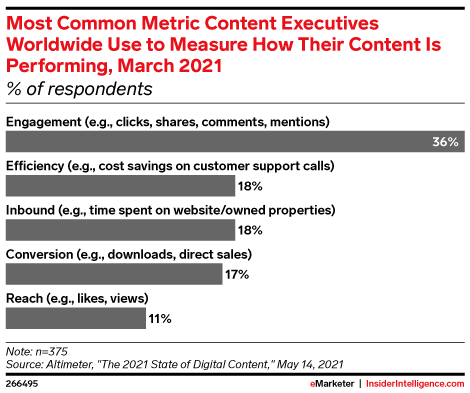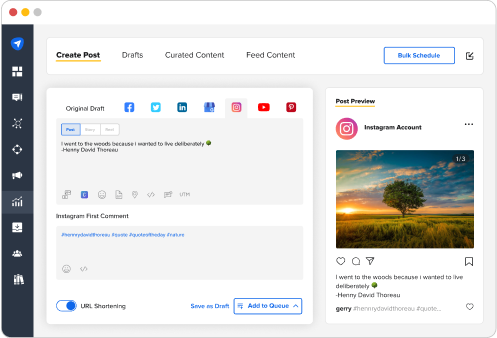Businesses spend a significant chunk of their marketing budget on social media, expecting to see results as soon as possible. It is one of the most effective digital marketing platforms today, with social media ad spending projected to reach more than $268 billion in 2023.
Despite the fast-growing popularity of social media marketing, over 44% of marketing agencies can’t measure social returns on investment for their clients.
This is one of the primary reasons why most marketing agencies find it challenging to attract and retain clients.
Proving your social media ROI enables you to understand the effectiveness of your social media marketing efforts, demonstrate value to the clients, and improves your strategy to deliver increased ROI over time.
Let’s examine why social ROI matters and the different metrics to measure it.
What Is Social Return on Investment?
Social ROI is the Return on Investment (ROI) you generate from different social media initiatives that create value for your brand. It is a metric that defines the tangible return or the amount of value that all social media actions deliver for your business.
Social ROI is typically measured as monetary value. However, non-monetary metrics also quantify ROI, especially when measuring the direct impact on your revenue is difficult.
For instance, if the goal of your social media campaign is to build brand awareness, the social ROI can be measured in the form of post impressions or follower count. Hence, your ROI may also capture how the social media campaign nurtures every relationship worth investing your time in. It entirely depends on your business objectives and how you quantify your social investment returns.
Embed CTAs (call-to-actions) and pop-ups into your website. This encourages users to click through and sign up for your newsletter, get a quote from your in-house marketers or even get a certain simple service for free – for example, an SEO audit for the customer’s website. By the way, the latter is a powerful lead-generation tactic, especially for a new business.
How Do You Calculate Social ROI?
Here is how social media ROI is calculated:
Social Media ROI = Profit/Investment x 100
Profit = The monetary value or money you earn from various social media marketing initiatives
Investment = The cost of all your social media marketing actions
Using this formula makes it simpler to measure ROI for your social media campaigns that can be attributed to a monetary value.
The below image will help you understand different metrics that connect your social media marketing campaigns to ROI at various stages of the buying journey:
Why Measuring Social ROI Matters?
There are various reasons why businesses need to measure social returns on investment. These include:
- Emphasize how your social media marketing campaigns are most effective in driving the desired results.
- Demonstrate the value of your social media marketing strategies for the brand.
- Identify areas of your campaign that work best for the business and address those that don’t.
- Determine the budget for different social media initiatives.
- Continuously optimize and improve your social media marketing strategies–enabling you to leverage best the tactics and resources that work.
Effectively communicating and understanding social media ROI can help grow your strategies and maximize your budget. Measuring the ROI makes it easier to justify spending on strategies delivering more value to the client than the cost.
Interesting read: Use this Social Media Strategy Template to Help You Save Time
6 Different Metrics to Measure Social ROI
How you measure social ROI depends on the organization’s objectives, including customer satisfaction, brand awareness, revenue, engagement, etc. Below is an example of the common metrics that content executives use to measure how the content is performing:

1. Conversion Rate
Conversion rates are essential for measuring social ROI as they directly tie to your business goals.
By tracking how many users take a desired action, you can determine the effectiveness of your social media content in driving conversions. This, in turn, helps identify which social media platforms, campaigns, or content types are most effective at driving conversions, allowing you to optimize your social media strategy for better results.
Additionally, tracking conversion rates can help you determine the ROI of your social media marketing efforts and demonstrate the value of social media to your stakeholders.
2. Choose the Right Metrics
Choosing the right metrics is crucial and should align with your objectives to help make better business decisions.
Vanity metrics such as likes, shares, and comments may help assess the general success of the campaign. On the other hand, you can use tangible metrics such as leads generated, website traffic, sign-ups, or conversions to measure the monetary value.
Whatever metrics you use, ensure you regularly monitor them. Measure the return on investment over a particular period depending on the sales cycle. Unless your goals, objectives, and metrics are on track, measuring and proving social ROI to your agency clients will be challenging.
3. Social Media Traffic and Followers
Social media traffic and followers are essential metrics to measure social ROI.
The former refers to the number of people visiting your website or landing page through various social media channels. Tracking this metric is crucial to help you understand how effectively your social media content drives traffic to your website, which can ultimately lead to conversions.
On the other hand, the number of followers on your social media channels reflects your brand’s reach and audience engagement. By tracking this metric, you can determine which content resonates with your audience and adjust your strategy to attract more followers and increase engagement. Doing so also helps identify potential brand advocates who can share your content and help grow your audience.
4. Track Product/Customer Reviews
Reviews are one of the biggest indicators of customer satisfaction levels, often attributed to greater sales and ROI.
According to a study, around 80% customers acknowledge that the experiences that brands provide matter as much as their products and services. Modern consumers are more informed and expect personalized offers and services. All these factors directly relate to the customer’s brand perception and are reflected in their reviews.
Improved positive reviews are an indicator of enhanced brand loyalty and higher ROI.
Track customer reviews on popular review sites to prove social returns on investment for your clients. Perform thorough research to understand the customers’ quality expectations and demand patterns. This will help you match their expectations to deliverables, determining the satisfaction level.
Monitoring how customers respond to social media marketing actions is crucial. This enables you to understand what’s working with them best and what’s not. Tracking positive customer reviews generated via your social media campaigns can help prove ROI for your clients because it typically reflects higher conversions.
5. Cost Per Acquisition
Cost per acquisition (CPA) is another important metric to track because it helps you understand the ROI of your social media campaigns.
CPA helps you determine the amount you spend on acquiring new customers through your social media marketing efforts. By comparing the CPA across different channels, you can optimize your budget and adjust your social media strategy accordingly. This allows you to allocate your resources toward the channels that offer the best ROI for your business.
To determine the CPA, you need to divide the total cost of your social media campaigns by the number of new customers acquired during that period. This allows you to compare the cost of acquiring customers through different channels and make informed decisions about where to allocate your marketing budget.
This metric can also help you optimize your campaigns by identifying which drives the most conversions at the lowest cost.
6. Brand Sentiment
Brand sentiment measures users’ general attitude or emotion towards your brand on social media platforms. This includes both positive and negative mentions that users make about your brand, products, or services.
Monitoring this metric is vital to help you understand how people perceive your brand and whether they have positive or negative associations with it. Over time, you can identify trends, track the impact of your marketing efforts, and adjust your social media strategy accordingly.
For instance, if you notice a negative trend in brand sentiment, you can address the issues causing negative feedback. This includes improving customer service, addressing product quality concerns, or creating engaging and positive content.
Interesting read: 8 Best Social Media Listening Tools to Power Your Marketing
3 Ways to Improve Social Media ROI
Use SocialPilot
One of the quickest ways to improve your client’s social ROI is by using a social media management tool like SocialPilot.
With SocialPilot’s scheduling tool, you can easily and quickly schedule content, which is very important because it helps:
- Organize content in advance rather than posting on multiple channels last minute.
- Your posts reach the right audience at the right time.

Social media feeds move really fast, so utilizing SocialPilot’s scheduling tool ensures your content reaches your client’s target audience when they are most likely to be active.
If that’s not enough, SocialPilot also features an analysis tool. The easily downloadable PDF report will help you get a deeper understanding of what works for your client’s social media, which you can directly deliver to them.
Optimize What You Post
if you’re running ads on social media platforms, try experimenting with different ad formats. You can try out various ways to see which delivers the best result. When you provide your clients with the social ROI report, include what you tried out and what worked the best for their social media and audience.
Take UK’s leading gym, PureGym, as an example. They saw a substantial increase of 11% in their memberships after adopting a new approach tailored to the Reels ads format on Instagram and Facebook. Furthermore, there was an 11% decrease in cost per purchase too, in comparison to the previous Reels ads.

Social ROI Should Always Be a Long-Term Goal
Always remember that social ROI is a long-term goal. So, don’t stress over short-term ROI targets you may not have achieved.
For instance, if you need to jump off a viral trend quickly just to get a bunch of comments and likes that provide your client’s audience with no real value, it could backfire and annoy them. Worse, it could seriously tarnish your brand voice and reputation, too.
Always think of the big picture to prove a positive social ROI to your client. A long-term focus allows agencies to track the impact of their social media efforts. This allows them to adjust their approach as needed, leading to improved performance and increased ROI for both the agency and their clients. In short, a long-term focus on social media ROI is essential for building trust and establishing a successful, sustainable partnership with clients.
Conclusion
As a marketing agency, your responsibility is to prove that your social media campaigns are highly effective in delivering higher yields for your client’s investments.
You can prove their social returns on investment by setting clear objectives & measurable goals, building an ROI dashboard, tracking customer reviews, establishing meaningful conversations, and regular reporting.



